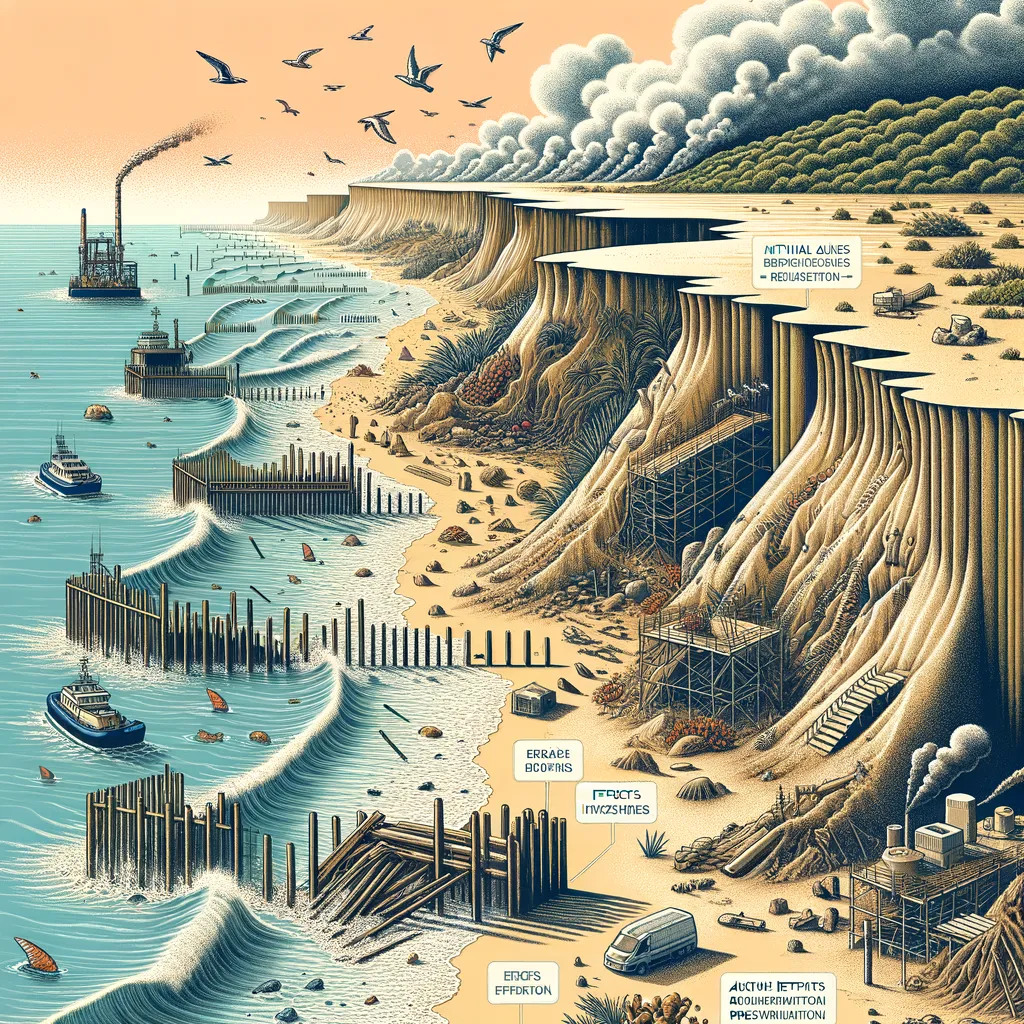Understanding Beach Erosion: A Comprehensive Guide for Parents
Welcome to our extensive guide on beach erosion, crafted especially for parents who are eager to educate themselves and their curious youngsters about this natural phenomenon. Beach erosion is more than just the loss of beautiful sandy beaches; it encompasses significant environmental implications that affect both the local ecosystem and recreational activities. By equipping yourself with knowledge on its causes, effects, and prevention methods, you can contribute to the preservation of our cherished coastal areas. For those who love camping by the beach, understanding and respecting our natural surroundings becomes even more crucial. Discover great camping tips and gear at Camping and Learn more here about how camping intertwines with nature’s delicate balance.
Introduction to Beach Erosion
Beach erosion, also known as coastal erosion, is the process wherein sea levels rise and storm surge, along with wave action, gradually wear away the shoreline. This natural process can be accelerated by human activities, leading to the loss of habitat, reduced recreational areas, and even damage to infrastructure. It is crucial for communities, especially those with children, to understand and mitigate the effects of beach erosion.
The Causes of Beach Erosion
The causes of beach erosion are multifaceted, ranging from natural processes to human-induced factors. Natural elements like wind, waves, and currents play a significant role in shaping the coastline. However, human activities such as construction near shorelines, sand mining, and the building of structures like jetties and seawalls can exacerbate the situation. Understanding these causes is the first step in addressing the issue effectively.
The Effects of Beach Erosion
Beach erosion can have far-reaching effects beyond just the loss of beachfront. The nesting habitats of marine turtles and birds are often disrupted, which can lead to a decrease in biodiversity. For families, the diminishing beaches mean less space for children to play and explore, potentially impacting their outdoor activities and connection with nature. Equally, the economic implications for communities reliant on tourism can be significant, affecting local businesses and employment opportunities.
Prevention Methods for Beach Erosion
To combat beach erosion, both hard and soft engineering practices have been employed. Hard engineering solutions include the construction of sea walls, groynes, and breakwaters. While these can be effective, they often disrupt the natural flow of sediment and can be costly. On the other hand, soft solutions, such as beach nourishment and dune regeneration, aim to work with nature by adding sand to beaches or planting vegetation to stabilize dunes. Community involvement in conservation efforts and responsible tourism practices can also play a pivotal role in preventing beach erosion.

Understanding Beach Erosion: A Comprehensive Guide for Parents
Welcome to our extensive guide on beach erosion, crafted especially for parents who are eager to educate themselves and their curious youngsters about this natural phenomenon. Beach erosion is more than just the loss of beautiful sandy beaches; it encompasses significant environmental implications that affect both the local ecosystem and recreational activities. By equipping yourself with knowledge on its causes, effects, and prevention methods, you can contribute to the preservation of our cherished coastal areas. For those who love camping by the beach, understanding and respecting our natural surroundings becomes even more crucial. Discover great camping tips and gear at [Camping](https://collinscampingandoutdoors.com/camping) and [Learn more here](https://en.wikipedia.org/wiki/Camping) about how camping intertwines with natures delicate balance.
Introduction to Beach Erosion
Beach erosion, also known as coastal erosion, is the process wherein sea levels rise and storm surge, along with wave action, gradually wear away the shoreline. This natural process can be accelerated by human activities, leading to the loss of habitat, reduced recreational areas, and even damage to infrastructure. It is crucial for communities, especially those with children, to understand and mitigate the effects of beach erosion.
The Causes of Beach Erosion
The causes of beach erosion are multifaceted, ranging from natural processes to human-induced factors. Natural elements like wind, waves, and currents play a significant role in shaping the coastline. However, human activities such as construction near shorelines, sand mining, and the building of structures like jetties and seawalls can exacerbate the situation. Understanding these causes is the first step in addressing the issue effectively.
The Effects of Beach Erosion
Beach erosion can have far-reaching effects beyond just the loss of beachfront. The nesting habitats of marine turtles and birds are often disrupted, which can lead to a decrease in biodiversity. For families, the diminishing beaches mean less space for children to play and explore, potentially impacting their outdoor activities and connection with nature. Equally, the economic implications for communities reliant on tourism can be significant, affecting local businesses and employment opportunities.
Prevention Methods for Beach Erosion
To combat beach erosion, both hard and soft engineering practices have been employed. Hard engineering solutions include the construction of sea walls, groynes, and breakwaters. While these can be effective, they often disrupt the natural flow of sediment and can be costly. On the other hand, soft solutions, such as beach nourishment and dune regeneration, aim to work with nature by adding sand to beaches or planting vegetation to stabilize dunes. Community involvement in conservation efforts and responsible tourism practices can also play a pivotal role in preventing beach erosion.
5 Things Parents Should Know About Preparing for Beach Erosion: Causes, Effects, and Prevention Methods
1. Educate and Engage – Educate your children about the significance of beaches to our ecosystem and how beach erosion impacts them. Engaging in local beach cleanups and conservation efforts can be a practical step towards making a difference.
2. Plan Responsible Visits – When visiting beaches, choose activities that do not harm the coastal environment. Avoid areas under restoration or protected for wildlife conservation. Supporting eco-friendly beach resorts and services that practice sustainable tourism can also make a big impact.
3. Foster Respect for Nature – Encourage respect for nature by teaching kids not to disturb natural habitats, wildlife, or remove sand and shells from beaches. Instilling these values can nurture a lifelong commitment to environmental conservation.
4. Stay Informed – Keep updated with local environmental projects and beach erosion activities in your area. This knowledge can be vital in understanding the challenges faced by your community and how you can contribute effectively.
5. Advocate for Change – As members of the community, parents can play a crucial role in advocating for sustainable practices and policies to address beach erosion. Whether through community meetings, social media, or by supporting environmental organizations, your voice can help drive positive change.
In conclusion, beach erosion is a critical issue that warrants our attention, especially as parents who lead by example. By understanding its causes, effects, and prevention methods, we can better prepare ourselves and our children to protect and respect our precious coastal environments. Through education, responsible actions, and community involvement, we can make a significant impact in preserving the beaches for future generations to enjoy.
Disclaimer
The articles available via our website provide general information only and we strongly urge readers to exercise caution and conduct their own thorough research and fact-checking. The information presented should not be taken as absolute truth, and, to the maximum extent permitted by law, we will not be held liable for any inaccuracies or errors in the content. It is essential for individuals to independently verify and validate the information before making any decisions or taking any actions based on the articles.




